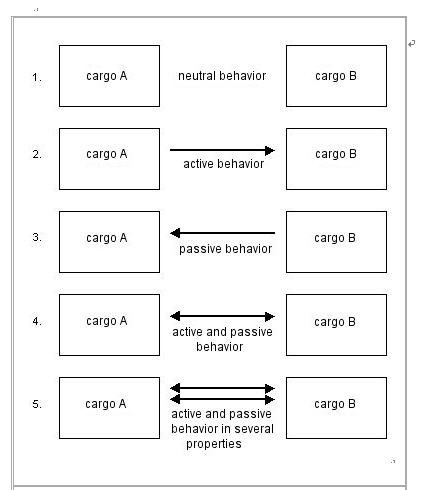If goods are to be stowed together when packing a container, the interrelationships between the transport properties of products must be taken into account, since disregarding them may result in quality degradation and damage. Goods may react with one another and possibly with their environment. They may be classified as follows, depending on their degree of active or passive reaction (see Fig. 57):
Figure 57: Compatibility relationships of goods

1. Goods displaying neutral behavior:
Mutually compatible goods are those which do not impair or damage one another when stored together in a warehouse or in a container during transport, i.e. display neutral behavior. These goods present no containerization problems, their neutral behavior meaning that they place no special requirements on container type nor on container stowage space; examples are ceramic fittings, roof tiles, construction plant, rough structural steel, boats etc. (WCC 0), which do not affect one another with regard to humidity/moisture, odor or contamination.
However, it must be remembered that the wooden crates or pallets (WCC 2) are moisture-sensitive and may therefore suffer a loss of stability. Sodden pallets may lose up to 50% of their strength. For instance, pallets carrying roof tiles which had stood for a long time in the open air became rotten and broken and clearly should have been classified as goods displaying passive behavior. This should be taken into account when considering neutral behavior.
2. Goods displaying active behavior:
Goods, one of whose particular properties has an active effect on other goods or on the environment, display active behavior. As a rule, the active behavior of a cargo results in unwanted changes, for instance it may cause quality degradation/damage in other goods. This means that a cargo displaying active behavior can only be stowed together with goods which do not deteriorate in quality or become damaged due to this active behavior, for example asafetida, a gum-resin, is known by its penetrating odor, which is difficult to remove and therefore must not be packed in a container together with odor-sensitive goods, but is itself not odor-sensitive.
3. Goods displaying passive behavior:
Goods which are sensitive to a particular property of other goods or of the environment, display passive behavior. Changes which are often irreversible and lead to quality degradation/losses are caused to the cargo by active behavior external to it, i.e. of other goods or the environment.
For instance, window glass, which does not contain any water (WCC 0) and therefore does not release any water vapor, could be dulled by a damp environment if stored in the open air for a relatively long time at the port of loading.
4. Goods displaying active and passive behavior:
Goods, one of whose particular properties displays both active behavior and passive behavior; they are capable both of causing quality degradation/damage to other goods and of undergoing quality degradation/damage as a result of other goods. An example is gum arabic, which on the one hand causes contamination by exuding sticky substances and on the other hand is sensitive to contamination in the same manner as foodstuffs.
5. Goods displaying active and passive behavior in more than one property:
These goods have several properties which display both active behavior and passive behavior, so meaning that they can have a greater quality-degrading/damaging effect on other goods while themselves being at increased risk from other goods.
These goods place the highest requirements on container type, stowage space and loss prevention. For instance, green coffee beans cause odor-tainting, i.e. they release a specific odor, while being themselves extremely odor-sensitive, e.g. in relation to a citrus odor, a pepper odor etc. Moreover, green coffee beans, especially washed coffee, release water vapor while furthermore being themselves very sensitive to moisture.








